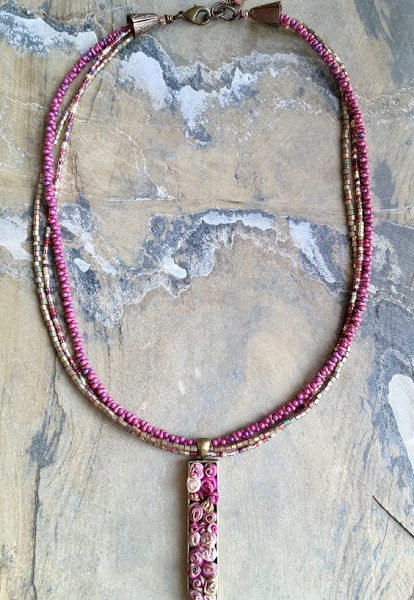Insula Dulcamara by Paul Klee, 1938
31 1/2 x 69 in
“Insula Dulcamara is the largest of Klee’s finished paintings. Its original title was “Insel der Kalypso” [Isle of Calypso]. Delicate colours, reminiscent of blooming plants, contrast with hard black lines; open, dynamic shapes with closed, static ones. As a base, Klee used printed newspaper mounted on burlap; he painted it with oil paints and coloured paste.
The symbols are taken from an elementary vocabulary of form and can be read in different ways. A line running from left to right in the top half of the picture is reminiscent of a serpent, the shape to its right looks like a piece of Arabic calligraphy. In the middle, a sallow face may be seen, which Klee returned to in his painting “Tod und Feuer”, 1940, 332 [Death and fire], in the last year of his life.
The original title of the painting refers to the initial image from Greek mythology – Odysseus’s sojourn on the isle of the nymph Calypso. While working on it, Klee broadened the subject to make a more open statement. The title “Insula dulcamara” awakens exotic associations, but at the same time it points out the opposites of sweet (Lat.: dulcis) and bitter (Lat.: amarus). He probably first refers to medicinal plants: “Solanum dulcamara” is the Latin name for the highly poisonous solanaceous herb »bittersweet«, which was used for healing due to its anti-inflammatory and metabolism-boosting properties. It is used to treat rheumatism, and helped ease Klee’s scleroderma. The scarlet fruits and small brown leaves dispersed about the painting are direct references to ripe “Solanum dulcamara”.”
About the Artist
“A Swiss-born painter and graphic artist whose personal, often gently humorous works are replete with allusions to dreams, music, and poetry, Paul Klee, b. Dec. 18, 1879, d. June 29, 1940, is difficult to classify.
Primitive art,
surrealism,
cubism, and children’s art all seem blended into his small-scale, delicate paintings, watercolors, and drawings. Klee grew up in a musical family and was himself a violinist. After much hesitation he chose to study art, not music, and he attended the Munich Academy in 1900.
Klee often incorporated letters and numerals into his paintings. These, part of Klee’s complex language of symbols and signs, are drawn from the unconscious and used to obtain a poetic amalgam of abstraction and reality. He wrote that “Art does not reproduce the visible, it makes visible,” and he pursued this goal in a wide range of media using an amazingly inventive battery of techniques. Line and color predominate with Klee, but he also produced series of works that explore mosaic and other effects.
Klee taught at the BAUHAUS school after World War I, where his friend Kandinsky was also a faculty member. In Pedagogical Sketchbook (1925), one of his several important essays on art theory, Klee tried to define and analyze the primary visual elements and the ways in which they could be applied. In 1931 he began teaching at Dusseldorf Academy, but he was dismissed by the Nazis, who termed his work “degenerate.” In 1933, Klee went to Switzerland. There he came down with the crippling collagen disease scleroderma, which forced him to develop a simpler style and eventually killed him. The late works, characterized by heavy black lines, are often reflections on death and war, but his last painting, Still Life (1940; Felix Klee collection, Bern), is a serene summation of his life’s concerns as a creator.”
Your entry this month can be influenced by the colors, pattern or whatever you choose to focus on for your creation. Just remember to include at least one art bead in your design.
The Prizes:
Winners will be randomly chosen from all the qualifying entries on May 1st.
From all the entries during the month, an editor is going to pick their favorite design to be featured every Monday here on the ABS. We want to give our participants more time in the spotlight! Our Featured Designer will be this Monday, so get those entries in soon.
How to enter the Monthly Challenge:
1. Create something using an art bead that fits within our monthly theme. This challenge is open to jewelry-makers, fiber artists, collage artist, etc. The art bead can be created by you or someone else. The challenge is to inspire those who use art beads and to see all the different ways art beads can be incorporated into your handiwork.
***Beads by themselves and beads simply strung on a chain or cord will not be accepted.***
Please add the tag or title APRILABS to your photos. Include a short description, who created the art beads and a link to your blog, if you have one.
Deadline is April 30th. Photos are approved by our moderators, if a photo hasn’t followed the guidelines it will not be approved. You may upload 2 photos a day.
What is an Art Bead?
An art bead is a bead, charm, button or finding made by an independent artist. Art beads are the vision and handiwork of an individual artist. You can read more about art beads here.
***A bead that is handmade is not necessarily an art bead. Hill Tribe Silver, Kazuri ceramic beads or lampwork beads made in factories are examples of handmade beads that are not considered art beads.
Beaded beads, stamped metal pendants or wire-wrapped compoments are not considered art beads for our challenge.***
p.s. If you have a blog, post your entry and a link to the ABS challenge to spread the beady goodness.


